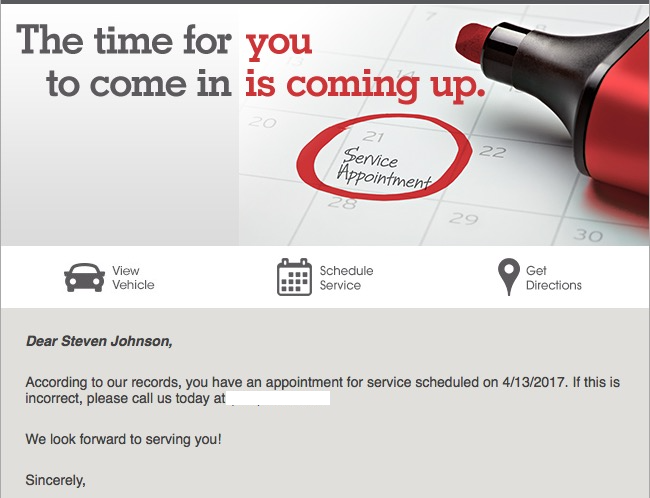Analyzing your Buyer’s Journey

“Consider this: most high school sports teams spend more time and money on win/loss analysis than most companies.” — Steve Johnson, Turn Ideas Into Products
About 5,000 miles or 6 months ago, I bought a new car. This week I got a personalized email from the dealership saying it was time for maintenance.
Now I usually use a mechanic right down the street but I thought. “I’ll give the dealership a chance.” So, I hit “Schedule an appointment,” and had to sign in from scratch. (What?—didn’t they know who I was after clicking a personalized link?) Made an appointment using their scheduling tool. Got two reminders, one via email, one via mobile phone. When I arrived at the dealership for my appointment, the service desk had no knowledge of me or the reservation. And no time available that day. (“You know how to take the reservation, you just don't know how to hold the reservation.”)
So I had to reschedule. Got a nice note confirming my new appointment.

Did you notice? The email confirmation doesn’t show the appointment time, only the day.
While I was muttering on the drive home, I thought about the disconnect between marketing, sales, and service. Why doesn’t one department know what another department is doing? After all, I bought and financed the car through the dealership. They emailed me a reminder. Yet the service department doesn't know me. How many times must I provide the same information: name, email, phone number, address?
I’d love to be interviewed by this vendor. A good product manager would examine this entire dysfunctional experience.
How will he or she know? By doing win loss analysis.
From my book Turn Ideas Into Products:
There’s one special form of research that most product teams are neglecting—and they’re missing a great tool. It’s win/loss analysis. Why do you win deals? Why do you lose deals? What patterns do you see?
Consider this: most high school sports teams spend more time and money on win/loss analysis than most companies.
You know what’s really scary? Executives don’t know why they win. They get annoyed by losses, sure, but it drives them crazy when they don’t know why their products win. After all, if you don’t know why you’re winning, how do you know what you can change? What should you do more of or stop doing?
My friend Alan of Eigenworks tells me the most common problem facing the adoption of win loss analysis is a lack of buy-in from sales leadership. Without top-down support, sales reps won’t surrender prospect lists and they feel attacked by the mere idea of someone analyzing their wins and losses. Many salespeople perceive win loss as a “witch-hunt” by product management or marketing. That’s why I strongly recommend outsourcing interviews and analysis to a third-party service like Eigenworks or The Win Loss Agency. After all, they have no political agenda.
Who better to tell you what your company does right and wrong than a customer—particularly one who has recently bought your product or service?
Have a chat soon (today?) with your sales leadership. “Don’t you want to know why we lose deals? Don’t you want to know why we win?”
You can and should improve customer communication at every step of the buyer’s journey. More often than not, what should be seamless is broken.

